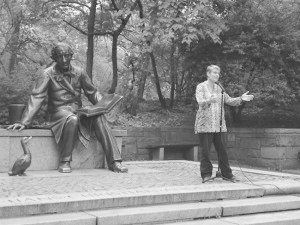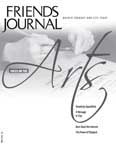Everything is held together with stories. That is all that is holding us together, stories and compassion. — Barry Lopez

At the little meeting I attend, a few of us teach First-day school using the storytelling technique of Faith & Play/Godly Play®. Not long ago I told the story of the testimonies, in which God is represented by fire and the testimonies arise from that spiritual fire. At the end of the story Davy, who was eight at the time, asked with a bit of anxiety, “Why is God represented by fire?” His sister, who is very wise, said, “God wouldn’t be a thing or a person, God changes things.” I said that meeting for worship felt to me like sitting around the warming fire of God’s love and that within meeting, we could all be changed, transformed by that loving fire. Davy said, “Ah, I get it, my family and I sit around the fire in the winter and keep cozy together. That’s like God’s love.” On another occasion I asked the children to draw God. Davy drew a wiggly, wild ball of energy, saying that he thought that was God, energy all around, like electrons moving, like a river of light. His sister drew a shadowy room, with a doorway at the end of a passageway, and said that God was like that doorway, offering an opening.
For nearly five years I have been blessed with getting to work with Quaker monthly and yearly meetings on helping members and attenders to tell their stories of spiritual experience. I teach a very structured listening process that involves the whole body, but which arises from the kind of listening that Quakers practice all the time, and extends that listening into honoring responses and questions. I don’t define spiritual experience for anyone, though I do tell my own stories to model the process. I have found the experience of making a space for meeting members to tell their most tender stories to be powerfully transformative for the meetings. As people tell what is closest to their hearts, I can perceive the warming fire of God’s love in the room, and the crucible of community at work. Often the tellers open themselves to very vulnerable moments and the willingness to share those moments, however raw or unresolved, is a powerful gift to the body of listeners. The gift of fully engaged listening reciprocates the gift of the telling and the stories become held by the community.
My friend Kathy Hyzy (an amazing storyteller and teacher in her own right) says that what we are doing is practicing the art of ministry and constructing narrative theology. Quakers practice an embodied faith; our faith is expressed in how we live. How do we talk about our faith, our connection to God/Spirit/Christ/Love, except by telling our stories? One thing that I’ve noticed in each workshop I’ve led is that the ways in which the variety of names that we give God/Spirit/Christ/Love have caused pain and obstruction for being in community fall away. When your name for God is spoken with all the flesh on, with the lived experience intact, hearts and minds open.
During one workshop a man told a story of the first time he felt God’s presence in meeting for worship—it was full of pain, and his sense that something was wrong with him. A few days later, he told the same story in the meeting talent show, and it was really funny. Telling the stories that scare us most, that make us tremble, within the context of community can cause healing all by itself. In this case, the plot was the same, but the way in which it was carried by the teller was what changed. This may make the process sound like therapy. Though it can be therapeutic, this story practice is essentially different from therapy in that wholeness for each person present is assumed, and also in that we each are resilient spiritual beings, able to hold what is painful and joyful together.
Some of my stories are as real to me as memories. Having told them over and over, lived with them, let them work on me, I find that they are as vivid and as much a part of my flesh and bones as the stories in which I have walked. The narratives we carry become the lenses through which we see, become the way we perceive and receive our lives. We grow within a broader culture that tells many toxic narratives. Becoming conscious and aware of the stories we hold and how they shape the way we live can be a powerful act of resistance. Just telling them to one another can shift the community and liberate the teller from the hold they have on him or her. Giving attention to that which is most holy, the spiritual bread, in each of our lives, can assist us in growing into the blessed community we seek.
Not long ago I went on a bird walk in Cobbs Creek Park with neighbors and my son and partner. We were accompanied by an Audubon naturalist accustomed to spotting hidden life among the brush and trees. This park for years has been in the news most often when murdered bodies were discovered there, but it has been reclaimed and revitalized by a nature center and by neighborhood assistance, and I love having such an oasis of marsh, creek, and woods so nearby our home. We were quiet and attentive. My son spotted a very lively water snake in the creek, and we saw a ruby-throated hummingbird, a cedar waxwing, Baltimore orioles, and a redtailed hawk. I hadn’t been birding before and loved the silent attentiveness required for spotting the birds, as well as the fellowship in watching for them together. The walk felt a little like meeting for worship with attention to bird spirits, and reminded me of the storytelling sessions. The sacred is omnipresent, and taking time to watch for it, to listen, makes all the difference in how we live.



Comments on Friendsjournal.org may be used in the Forum of the print magazine and may be edited for length and clarity.